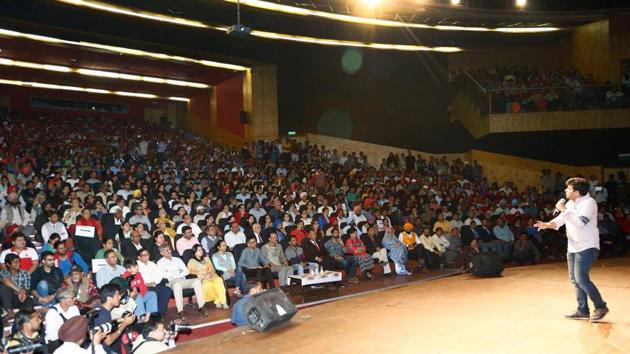Why an increasing number of stand-up comedians are choosing to talk in Hindi
Indian stand-up comedy as we know it was born in English. But its coming of age could well be in Hindi.
In the last seven odd years, we’ve seen the rise of stand-up comedy in a way no one really anticipated. Every second bar in a hip neighbourhood now hosts open mic nights; and Indian comedians are touring Dubai and Singapore. It’s not a stretch to say that comedians are the new superstars of this generation. They receive the kind of adulation that was reserved for actors and cricketers — fan art, fan pages on social media, and being hounded for selfie requests.

Carving their niche within this space now is a new subset of stand-up comics. The ones that prefer using Hindi as their medium. Performers such as Zakir Khan and Abhishek Upmanyu are comics who grew up in predominantly Hindi-speaking cities such as Indore and Delhi. And what’s driving their decision to use Hindi on stage is the need to stay true to their own experiences.
“I didn’t go to a fancy English-medium school. If I’m talking about something that happened 15 years ago, it will have to be in Hindi. Every story has its own language,” says Delhi-born comic Sanjay Rajoura (43), known for his social satire.
Not what you’d expect
Until recently, Hindi comedy was associated with what we saw on TV: shows such as The Great Indian Laughter Challenge or Comedy Circus in the mid-2000s were immensely popular. The jokes heavily relied on mockery, mimicry, or slapstick. That’s true even today for Comedy Nights with Kapil. One of India’s most-loved comics, Johnny Lever, too was known for mimicry. “Initially, people would expect that [from us],” says Tandon. In contrast, stand-up comedians using Hindi rely on observational humour, opinions and satire.
The current shift in language is all the more significant when seen in context of how modern Indian stand-up comedy came via the West. Every Indian comedian worth his/her salt invariably names Louis CK (legendary American comic who started out in the ’80s) as an inspiration. And pioneering Indian comics such as Vir Das and Papa CJ cut their teeth in USA and UK respectively, before returning to India and kicking off a new industry. Even though their themes were Indian, it was only natural that their style and influences were western.
READ MORE: Check out how the Mumbai-comedy scene evolved over the years
Initially, when Delhi-based comedian Amit Tandon (41) was testing waters at open mics seven years ago, he used more English than Hindi. “There was a pressure to speak in English; everyone else was doing it,” he admits. Now, his sets are a mix of English and Hindi. “It’s how I usually speak. Comedy works best when you are yourself on stage.” Some of Tandon’s viral videos are about his middle-class upbringing, and their perception and aspiration towards luxury.
Language no barrier
It’s not just the northern Hindi-speaking belt of India, but cities such Chennai and Bengaluru that are large welcoming these comedians. Delhi boy Abhishek Upmanyu (26), who moved to Mumbai two years ago, says, “People have seen your videos [on YouTube]. So they know what to expect.” A clip of Upmanyu talking about sarcastic Indian parents went viral earlier this year (2017). It’s evident that he’s a rapid speaker with a peculiar north Indian accent. “Once, in Bengaluru [before the viral videos], I asked the crowd if they understood Hindi, and they said yes. But soon enough, they couldn’t follow me. They said, ‘Hume yeh wali Hindi nahi aati hai.’”
But by and large, the reason Hindi doesn’t isn’t restrictive is because, with the ever-increasing cross migration between cities, the kind of crowd who comes for a live stand-up show tends to be cosmopolitan. In a way, Hindi democratises stand-up comedy. At a corporate show for an automobile firm in Delhi, Tandon was asked to perform a set in English. On reaching the venue, he saw that the crowd comprised of workers from the manufacturing unit. “I was told they understand English. It’s not about understanding the basics but connecting with the jokes,” he says. He performed in English for the first five minutes only to be met with dead silence. He switched to Hindi for the rest of his set.
In India, a mainstream phenomenon doesn’t take long to go regional. We saw that with the web series boom. As the medium took off in Hindi and Hinglish, it wasn’t long before Marathi and Tamil web shows cropped up. So, evidently, there’s a willing audience for new-age entertainment in regional languages. Now that Hindi comedians have found success, stand-up comedy in other native Indian languages could be the next big thing. It will certainly be interesting to see the fresh themes, accents, and humour that those stand-up comics will bring to the scene.





